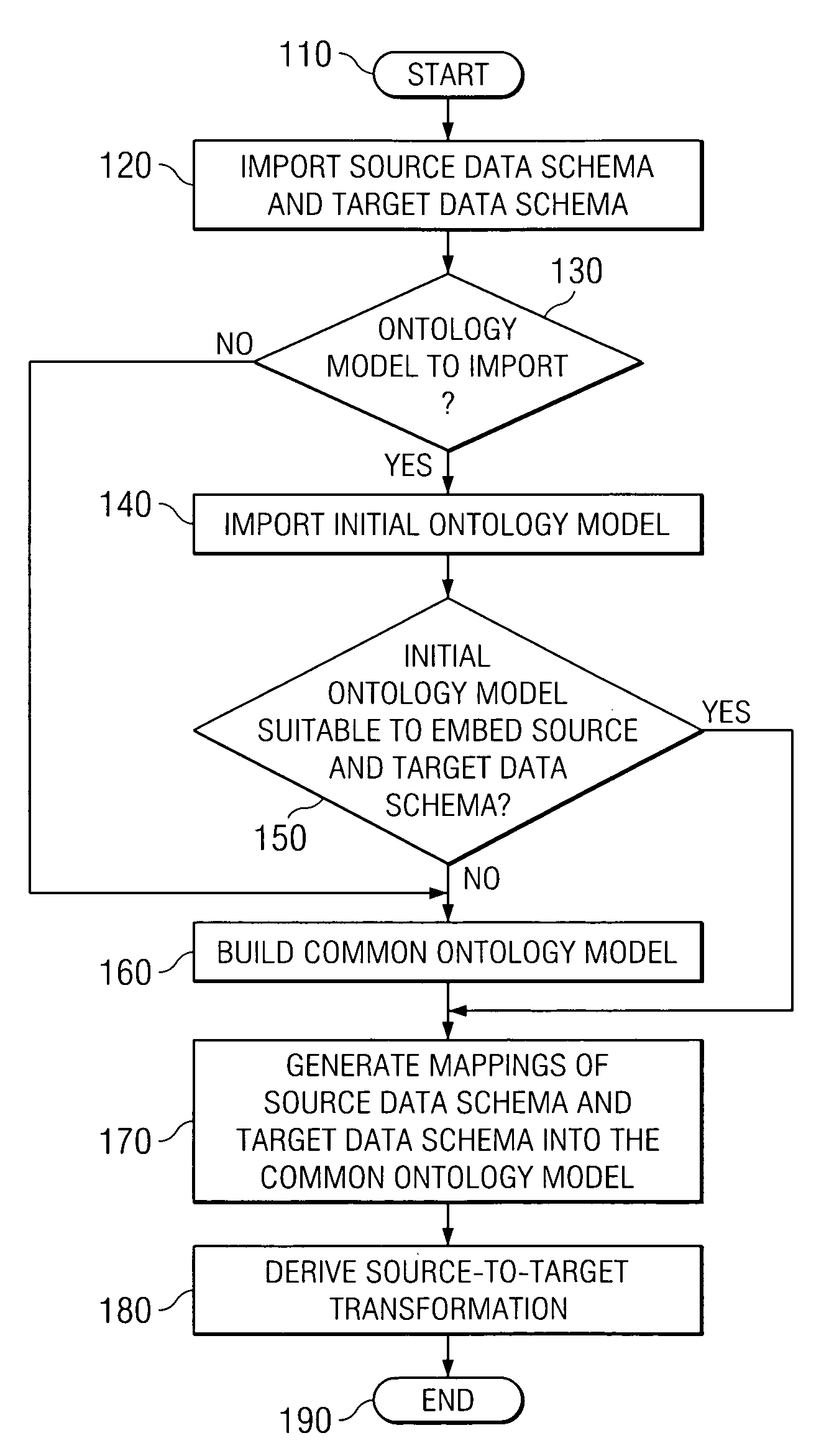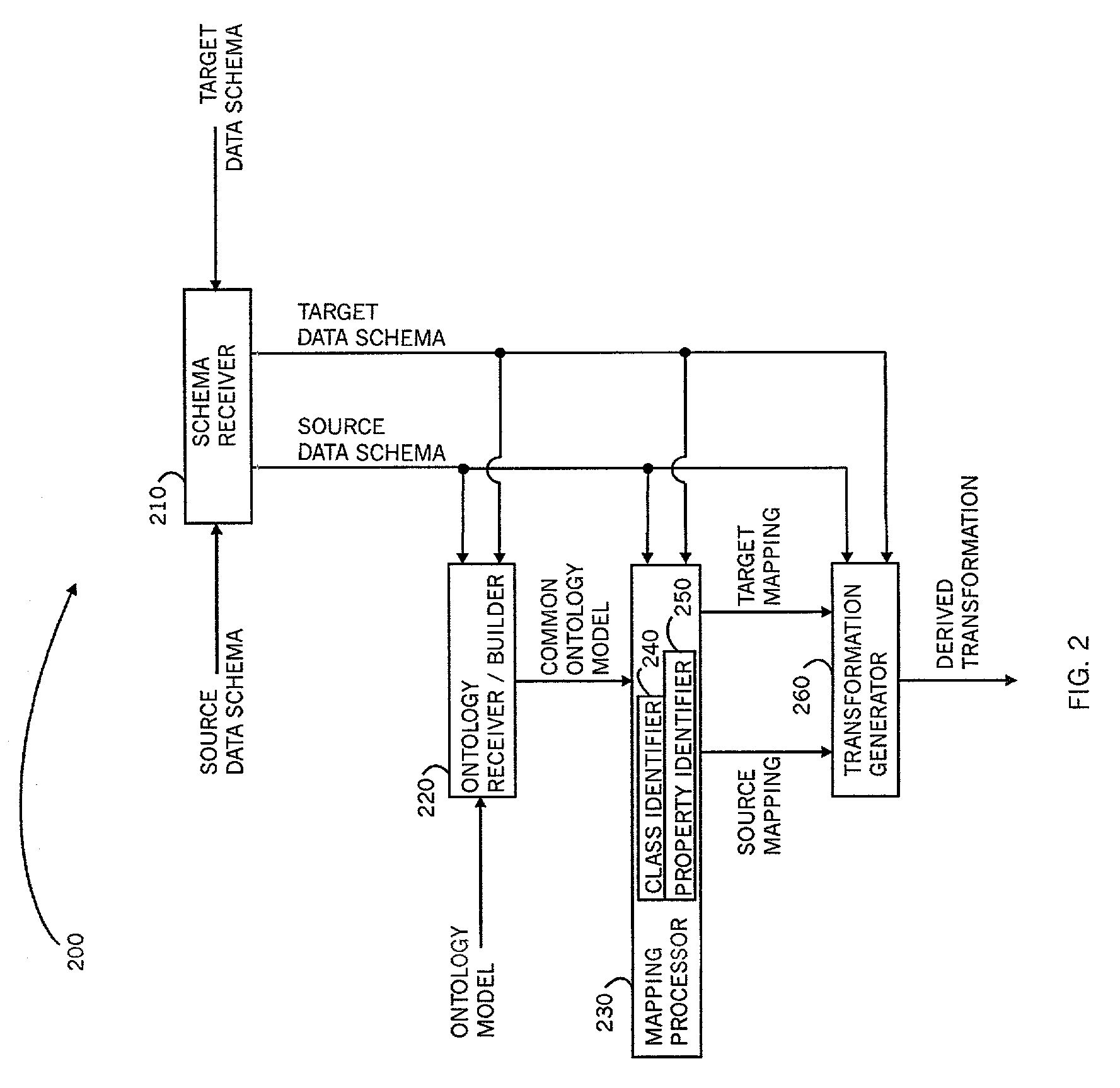Run-time architecture for enterprise integration with transformation generation
a run-time architecture and transformation technology, applied in the field of data schema, can solve the problem that data cannot be easily imported or exported from one application to another, and achieve the effect of facilitating data import and expor
- Summary
- Abstract
- Description
- Claims
- Application Information
AI Technical Summary
Benefits of technology
Problems solved by technology
Method used
Image
Examples
examples
[0202]For purposes of clarity and exposition, the workings of the present invention are described first through a series of twenty-three examples, followed by a general description of implementation. Two series of examples are presented. The first series, comprising the first eleven examples, relates to RDBS transformations:. For each of these examples, a source RDBS and target RDBS are presented as input, along with mappings of these schema into a common ontology model. The output is an appropriate SQL query that transforms database tables that conform to the source RDBS, into database tables that conform to the target RDBS. Each example steps through derivation of source and target symbols, expression of target symbols in terms of source symbols and derivation of an appropriate SQL query based on the expressions.
[0203]The second series of examples, comprising the last twelve examples, relates to XSLT transformation. For each of these examples, a source XML schema and target XML sc...
fourth example
A Fourth Example
Lineage
[0281]In a fourth example, a target table is of the following form:
[0282]
TABLE XLIIITarget Table T for Fourth Example
[0283]One source table is given as follows:
[0284]
TABLE XLIVSource Table S for Fourth and Fifth Examples
[0285]The underlying ontology is illustrated in FIG. 15. The dotted portions of the ontology in FIG. 15 are additional ontology structure that is transparent to the relational database schema. The unique properties of the ontology are:
[0286]
TABLE XLVUnique Properties within Ontology for Fourth and Fifth ExamplesPropertyProperty Indexname(Person)1ID#(Person)2
[0287]The mapping of the target schema into the ontology is as follows:
[0288]
TABLE XLVIMapping from Target schema to Ontology for Fourth ExampleschemaOntologyProperty IndexTClass: PersonT.IDProperty: ID#(Person)2T.NameProperty: name(Person)1T.Father_NameProperty: name(father(Person))1o3
[0289]The mapping of the source schema into the ontology is as follows:
[0290]
TABLE XLVIIMapping from Source...
fifth example
A Fifth Example
Lineage
[0297]In a fifth example, the target property of Father_Name in the fourth example is changed to Grandfather_Name, and the target table is thus of the following form:
[0298]
TABLE LTarget Table T for Fifth Example
[0299]One source table is given as above in Table XLIV.
[0300]The underlying ontology is again illustrated in FIG. 15. The unique properties of the ontology are as above in Table XLV.
[0301]The mapping of the target schema into the ontology is as follows:
[0302]
TABLE LIMapping from Target schema to Ontology for Fifth ExampleschemaOntologyProperty IndexTClass: PersonT.IDProperty: ID#(Person)2T.NameProperty: name(Person)1T.Grandfather_NameProperty: name (father(father1o3o3(Person)))
[0303]The mapping of the source schema into the ontology is given in Table XLVII above.
[0304]The indices of the source properties are given in Table XLVIII above.
[0305]The indices of the target properties, keyed on ID are:
[0306]
TABLE LIITarget Symbols for Fifth ExampleTableTarget S...
PUM
 Login to View More
Login to View More Abstract
Description
Claims
Application Information
 Login to View More
Login to View More - R&D
- Intellectual Property
- Life Sciences
- Materials
- Tech Scout
- Unparalleled Data Quality
- Higher Quality Content
- 60% Fewer Hallucinations
Browse by: Latest US Patents, China's latest patents, Technical Efficacy Thesaurus, Application Domain, Technology Topic, Popular Technical Reports.
© 2025 PatSnap. All rights reserved.Legal|Privacy policy|Modern Slavery Act Transparency Statement|Sitemap|About US| Contact US: help@patsnap.com



